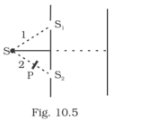Question:
The figure shown a two-slit arrangement with a source which emits unpolarised light. P is a polariser with axis whose direction is not given. If I0 is the intensity of the principal maxima when no polarizer is present, calculate in the present case, the intensity of the principal maxima as well as of the first minima.

Solution:
Amplitude of the wave in perpendicular polarisation
$A_{\perp}=A_{\perp}^{0}(\sin (k x-\omega t)+\sin (k x-\omega t+\phi))$
Amplitude of the wave in parallel polarisation
$A_{\|}=A_{\|}^{0}(\sin (k x-\omega t)+\sin (k x-\omega t+\phi))$
Intensity at the first minima with polariser
$\left|A_{\perp}^{0}\right|^{2}(1-1)+\frac{\left|A_{\perp}^{0}\right|^{2}}{2} \cdot \frac{1}{2}=\frac{I_{0}}{8}$
